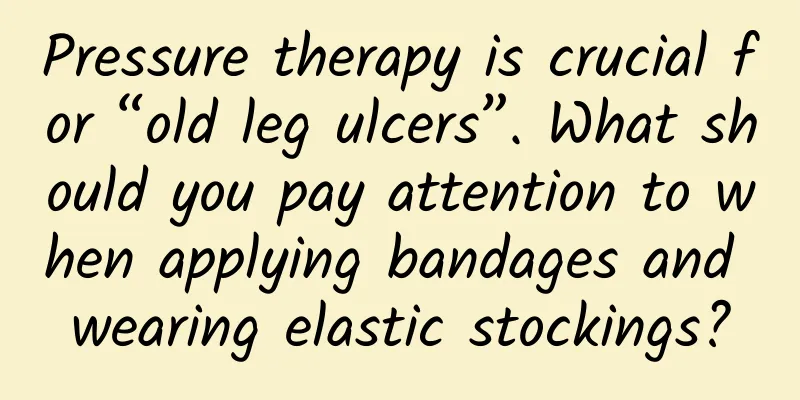Pressure therapy is crucial for “old leg ulcers”. What should you pay attention to when applying bandages and wearing elastic stockings?

|
Author: Zhang Xin, Head Nurse, Beijing Tongren Hospital, Capital Medical University Member of the Expert Database of the Disaster Nursing Professional Committee of the Chinese Nursing Association Reviewer: Liu Changwei, Chief Physician, Peking Union Medical College Hospital Venous leg ulcers are skin and subcutaneous tissue lesions caused by chronic venous insufficiency and venous hypertension, often referred to as "old rotten legs". They are more common in the anterior tibia and the upper medial part of the ankle joint, mainly in the foot and boot area, and the incidence rate is increasing year by year, especially in elderly patients. The main cause of venous ulcers of the lower limbs is venous hypertension. Long-term venous hypertension can cause lower limb edema, followed by insufficient blood and oxygen supply to tissues, microcirculation disorders, and inflammatory reactions, ultimately leading to venous ulcers of the lower limbs, causing great distress to patients. Compression therapy is the gold standard for the treatment of venous leg ulcers. It is widely used and is a mature treatment method. The most commonly used pressure therapy methods are short-stretch bandages, composite pressure bandage systems, compression stockings, and intermittent pneumatic pressure therapy devices. Pressure therapy is mainly used to combat pathological venous hypertension, promote venous return and redistribution in the lower limbs, minimize swelling in the calves or feet, and thus accelerate wound healing. 1. What should patients with venous lower limb ulcers pay attention to when applying bandages? Bandages are usually wrapped from the toes to below the knee joint using a short extension bandage. When bandaging, the ankle pressure must be higher than the knee pressure, and the pressure value must be greater than 40 mmHg to effectively reduce venous hypertension and promote venous return in the lower limbs. Figure 1 Original copyright image, no permission to reprint When undergoing pressure therapy, you must walk more and walk normally. Proper exercise can activate the calf muscle pump function and promote the movement function of the ankle, thereby promoting wound healing. Some patients who cannot walk normally or are bedridden can do some foot exercises, such as hanging the foot, flat foot, and lifting the foot. Alternating exercises like this, doing functional exercises for 30 minutes each time, can also achieve the effect of promoting venous return in the lower limbs. How long can a bandage last for a venous leg ulcer? This depends on whether the circumference of the limb has changed and the amount of exudate from the wound. Some bandages may last for hours, while others may last for days, depending on individual differences. Every time you change the bandage, you should closely observe the affected limb to see if there are any indentations on the skin around the wound, any skin damage, or any atypical swelling caused by compression stenosis. If any of these occur, stop the pressure therapy immediately, find out the cause, and make timely changes. In addition, if there is a change in the volume of the lower limbs, the bandage becomes loose, there is discomfort or pain, exudation, or infection occurs during pressure therapy, pressure therapy should be stopped immediately. 2. How do patients with venous leg ulcers maintain bandages and compression stockings? Pressure bandages are reusable, and some can be washed 10-15 times, or even 50 times. How long they can last depends on how well they are maintained. Whether it is a pressure bandage or compression stockings, the better they are maintained, the longer they can last. The pressure bandage should be cleaned every day with hot water below 95°C to avoid cross infection. Buy two pairs of compression stockings as much as possible and use them alternately to ensure long-lasting pressure therapy, because they need to be washed every day, and they must be washed by hand, not machine-washed, and cannot be washed with alkaline soap. The water temperature is usually controlled at 30-40℃, and they cannot be tumble dried. Once the compression stockings are damaged, the pressure value will be uneven, and they cannot be repaired by themselves, so they must be replaced in time. Figure 2 Original copyright image, no permission to reprint After washing, pressure bandages and stockings should be laid flat on a clothes rack to dry without any wrinkles. 3. How to care for the wounds of patients with venous ulcers of the lower limbs? The skin around the venous ulcer of the lower limb is very fragile and prone to maceration or skin damage. Use some skin protection film for spraying to prevent maceration. Or apply moisturizing oil to protect the skin from ulceration. If contact dermatitis occurs, see a dermatologist in time for treatment. Some patients will also develop eczema, and the effect of topical antibiotics is still good. This is the care for the skin around the wound. For wounds, there is a lot of exudate on the wound surface, and exudate management is very important. During the wound treatment process, the moisture balance of the wound bed must always be maintained. Generally, foam dressings are selected to bandage the wound; when there is a moderate to large amount of exudate, alginate and foam dressings are used in combination; for extremely large amounts of exudate, the infection is particularly severe, and the area is particularly large, in addition to choosing highly absorbent dressings such as hydrophilic fibers, the cause must also be found to see if the pressure treatment is in place. For wound infections, some antibacterial dressings can be used in the short term, but not for a long time. Once the infection is localized, antibacterial dressings can no longer be used. During the swelling reduction period of pressure therapy, it is recommended to use a short-stretch bandage for wrapping. After the wound heals, it is the maintenance period of pressure therapy. Patients can wear pressure stockings and insist on wearing them to ensure the continuity of pressure therapy. Pressure therapy requires the patient to accompany the patient throughout his life, but it is actually quite difficult to persist in pressure therapy throughout his life. First of all, the patient must fully understand the disease and know the importance of pressure therapy; second, patients should communicate and share experiences with each other more often; the wound will get better and the recurrence rate will decrease, which will give the patient a sense of happiness and improve the patient's compliance with pressure therapy. |
>>: Latest research: Alzheimer's disease is quietly getting younger
Recommend
Is diabetes closely related to genetics and lifestyle? What else should we pay attention to besides blood sugar?
Author: Li Guangwei, Chief Physician, Fuwai Hospi...
Canalys: Global smart audio device shipments will exceed 500 million units in 2025
According to the latest estimates by Canalys, glo...
Can I have a massage during my period?
We should all be familiar with menstruation in ou...
Can I soak my feet after a cesarean section?
Cesarean section is a very common means of delive...
2014: The Year of Small Business Social: How Small Businesses Can Leverage Social Media – Infographic
For large companies with marketing budgets of mil...
What to do if you have menstrual cramps
Dysmenorrhea is a problem that many women will en...
How to maintain after abortion
Abortion can be called a short confinement period...
Learn to eat these foods during confinement, and you will get milk.
During the confinement period, some people may be...
How to apply eye shadow for beginners
Many girls need to dress up carefully before goin...
This kind of dental disease is more troublesome than tooth decay, so it must be prevented in advance!
This is the 3775th article of Da Yi Xiao Hu As we...
Low menstrual flow and low estrogen levels
For women, menstruation is very important. Of cou...
What to do if too much milk causes breast pain
In order to maintain their figure, many postpartu...
How many days should the gauze be removed from the cesarean section incision?
We all know that cesarean section requires incisi...
What can't be eaten with chrysanthemum brain? What can be eaten with chrysanthemum brain?
Chrysanthemum has a history of more than 2,500 ye...
A woman has a little urgency to urinate and blood in urine
The reproductive structure of women is relatively...









